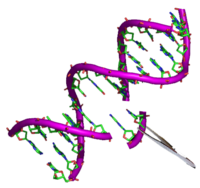
Photo from wikipedia
Bacillus thuringiensis (Bt) is a bacterium capable of producing Cry toxins, which are recognized for their bio-controlling actions against insects. However, a few Bt strains encode proteins lacking insecticidal activity… Click to show full abstract
Bacillus thuringiensis (Bt) is a bacterium capable of producing Cry toxins, which are recognized for their bio-controlling actions against insects. However, a few Bt strains encode proteins lacking insecticidal activity but showing cytotoxic activity against different cancer cell lines and low or no cytotoxicity toward normal human cells. A subset of Cry anticancer proteins, termed parasporins (PSs), has recently arisen as a potential alternative for cancer treatment. However, the molecular receptors that allow the binding of PSs to cells and their cytotoxic mechanisms of action have not been well established. Nonetheless, their selective cytotoxic activity against different types of cancer cell lines places PSs as a promising alternative treatment modality. In this review, we provide an overview of the classification, structures, mechanisms of action, and insights obtained from genetic modification approaches for PS proteins.
Journal Title: Molecules
Year Published: 2021
Link to full text (if available)
Share on Social Media: Sign Up to like & get
recommendations!